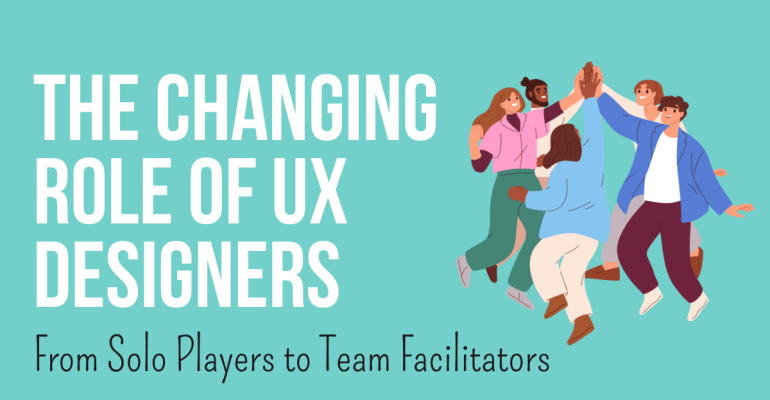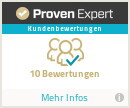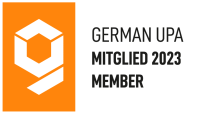The Changing Role of UX Designers: From Solo Players to Team Facilitators
13. Juni 2023 2023-09-28 16:00The Changing Role of UX Designers: From Solo Players to Team Facilitators

The Changing Role of UX Designers: From Solo Players to Team Facilitators
In the fast-paced design world, the role of UX designers has undergone a remarkable transformation. Gone are the days when they were the solitary owners of the user experience, toiling away in isolation. Today, the landscape has shifted, demanding a collaborative approach that harnesses the collective brilliance of teams and individuals across the organisation. As a UX and Leadership coach, I firmly believe that we are moving away from being the sole guardians of UX and evolving into facilitators who empower others to contribute to a remarkable user experience.
The digital revolution has catapulted us into a world where technology is deeply woven into the fabric of our lives. With this profound change comes an array of user expectations and needs that constantly evolve. The complexity of modern products and services further compounds the challenge, requiring UX designers to possess a broader skill set. In this environment, it is becoming increasingly clear that collaboration and teamwork are the keys to success.
The new role of UX designers extends far beyond being design experts. It requires a mindset that embraces empathy, effective communication, and the ability to foster collaboration. A facilitator empowers team members and other stakeholders to actively contribute their unique insights and expertise, all with the shared goal of delivering exceptional user experiences.
Throughout this article, we will explore the facets of the changing role of UX designers and the art of facilitation. We will delve into the benefits of collaboration with team members, the importance of reaching beyond the design team, and the tools and methods available to facilitate this new approach. Moreover, we will address potential challenges and offer strategies for ensuring success in this evolving role.
Evolving Landscape of UX Design
In the ever-evolving landscape of UX design, change is the only constant. Technology advances at an astonishing pace, and user expectations soar to new heights with each passing day. As UX designers, we find ourselves navigating a dynamic environment where adaptability and versatility are paramount.
The advent of smartphones, wearables, voice assistants, and many other digital devices has transformed how users interact with technology. It has elevated their expectations for seamless, intuitive, and delightful experiences across various touchpoints. Users now demand personalised journeys, frictionless interactions, and instant gratification.
To meet these evolving needs, UX designers have had to expand their skill sets. While expertise in user research, information architecture, and interaction design remains crucial, the new role of a UX designer extends beyond these realms. We must now be proficient in data analysis, business strategy, and even psychology to truly understand the complexities of the user experience.
This expanded role has led to a fundamental shift in how we approach our work. We are no longer solitary players responsible for all aspects of UX design. Instead, we have become advocates for collaboration and teamwork. The complexity of modern products and services necessitates diverse perspectives and a holistic approach to problem-solving.
By embracing collaboration, UX designers invite other team members—developers, product managers, marketers, and stakeholders—to contribute their unique insights from the earliest stages of the design process. This multidisciplinary approach fosters a collective understanding of user needs, business goals, and technical constraints. It breaks down silos and encourages shared ownership of the user experience.
Moreover, the expanding role of UX designers as facilitators helps bridge the gap between different teams and departments. We become the translators who bring together diverse perspectives, ensuring that the end product is visually appealing, functional, usable, and aligned with the organisation’s broader objectives.
In this shifting landscape, adaptability and a growth mindset are essential. As UX designers, we must be open to learning new skills, exploring emerging technologies, and keeping a finger on the pulse of industry trends. By staying informed and embracing change, we position ourselves as valuable contributors to the collaborative ecosystem of design and user experience.
The evolving landscape of UX design presents an exciting opportunity for us to shape the future of how products and services are designed, developed, and experienced. As facilitators, we have the privilege of bringing together diverse talents and perspectives, nurturing a culture of collaboration, and ultimately delivering outstanding user experiences. In the following sections, we will delve deeper into the core qualities of a facilitator and explore the benefits of collaboration with team members across disciplines.
The Facilitator Mindset
In the changing role of UX designers, adopting a facilitator mindset is crucial. As facilitators, we act as guides, enablers, and catalysts for collaboration. We create an environment where diverse voices are heard, ideas are shared, and the team’s collective intelligence is harnessed to achieve exceptional user experiences.
- Cultivating Empathy: At the heart of the facilitator mindset lies empathy—the ability to understand and share the feelings and perspectives of others. Empathy helps us build rapport, establish trust, and create an inclusive atmosphere where everyone’s contributions are valued. By putting ourselves in the shoes of team members, stakeholders, and users, we can better understand their needs and aspirations, ultimately leading to more impactful design solutions.
- Effective Communication: Clear and effective communication is the foundation of successful collaboration. As facilitators, we must articulate ideas, actively listen to others, and foster open dialogue. By creating a safe space for discussion, we encourage team members to freely express their thoughts, concerns, and creative insights. Strong communication skills also enable us to bridge the gap between technical jargon and layman’s terms, ensuring that everyone involved understands and aligns with the vision for the user experience.
- Nurturing Collaboration: Facilitators excel at fostering collaboration by creating an environment that encourages teamwork and cooperation. We break down barriers and promote a culture where everyone feels empowered to contribute. Through effective facilitation techniques, such as brainstorming sessions, collaborative workshops, and design sprints, we unlock the team’s collective intelligence. By embracing a co-creative approach, we tap into the diverse skill sets and perspectives within the group, leading to innovative solutions that may not have emerged through individual efforts.
- User-Centred Culture: A crucial aspect of the facilitator mindset is cultivating a user-centred culture throughout the organisation. As UX designers, we are champions for the end user and must inspire others to adopt the same user-centric mindset. By sharing user insights, conducting user research collaboratively, and involving stakeholders in the design process, we help align the entire team around the needs and goals of the users. This fosters a sense of shared responsibility for the user experience and ensures that decisions are made with the end user in mind.
- Adaptability and Continuous Learning: Facilitators understand that learning is a lifelong journey. In the ever-evolving field of UX design, being adaptable and embracing a growth mindset is vital. We must stay curious, seek new knowledge and skills, and stay updated on emerging technologies and industry trends. By continuously expanding our repertoire, we can better guide teams and adapt to the changing needs of users and the organisation.
By embracing the facilitator mindset, UX designers become the catalysts for collaboration, enabling teams to achieve outstanding user experiences. Our role extends beyond design expertise as we empower individuals, nurture a user-centred culture, and foster effective communication and collaboration.
Collaboration with Team Members
In the changing landscape of UX design, collaboration with team members from different disciplines is essential for creating exceptional user experiences. By involving diverse perspectives and expertise, we tap into a wealth of knowledge and unlock the potential for innovative solutions. Let’s explore the benefits of collaboration within the design team and the techniques that facilitate effective collaboration.
Benefits of Collaboration
- Diverse Perspectives: Collaboration brings together individuals with different backgrounds, skills, and experiences. This diversity leads to fresh insights, creative ideas, and a broader understanding of user needs.
- Holistic Problem-Solving: When team members collaborate, they approach problems from various angles, considering technical feasibility, business goals, and user requirements. This holistic approach results in well-rounded solutions.
- Enhanced Creativity: Collaboration sparks creativity as team members bounce ideas off one another, building upon each other’s contributions. It encourages out-of-the-box thinking and promotes innovation.
- Ownership and Engagement: When team members are involved in the design process, they feel a sense of ownership and pride in the final outcome. This level of engagement fuels motivation and fosters collective responsibility for delivering exceptional user experiences.
Collaborative Techniques:
- Design Sprints: Design sprints unite team members for intensive problem-solving and decision-making. Participants ideate, prototype, and test solutions in a time-boxed format, rapidly iterating towards a validated design concept.
- Workshops: Collaborative workshops gather stakeholders, designers, and other team members to explore ideas, align on goals, and generate solutions. These sessions foster creativity, encourage collaboration, and help build consensus.
- Cross-functional Meetings: Regular cross-functional meetings provide a platform for ongoing collaboration, where team members share progress, discuss challenges, and seek input from different perspectives. These meetings ensure continuous communication and alignment among team members.
- Co-creation Sessions / Pair-designing: Co-creation involves collaborative ideation and prototyping sessions where team members collectively contribute to the design process. This technique fosters a sense of shared ownership and generates valuable insights by involving stakeholders and end users.
Establishing Collaborative Relationships:
- Effective Communication Channels: Utilise communication tools and platforms that facilitate open, transparent, and efficient communication among team members. This helps bridge gaps in physical location and time zones, enabling seamless collaboration.
- Shared Documentation: Maintain a centralised repository of design artefacts, research findings, and project documentation accessible to the entire team. This promotes knowledge sharing, reduces duplication of effort, and ensures everyone is aligned and informed.
- Trust and Psychological Safety: Cultivate an environment of trust and psychological safety where team members feel comfortable sharing their ideas, concerns, and perspectives. Foster a culture that values diverse opinions and encourages respectful and constructive feedback.
Collaboration with team members empowers UX designers to leverage the collective intelligence and expertise within the organisation. By embracing diverse perspectives, engaging in collaborative techniques, and establishing effective communication channels, we can unlock the team’s full potential and deliver exceptional user experiences.
Collaboration Beyond the Design Team
In the changing role of UX designers, collaboration extends beyond the immediate design team. Engaging with stakeholders, product managers, developers, and other departments within the organisation is essential for creating cohesive and impactful user experiences. Let’s explore the significance of collaboration beyond the design team and its value to the UX design process.
- Alignment of Goals and Vision: Collaboration with stakeholders and product managers ensures that the UX design aligns with business goals and objectives. By involving them from the early stages of the design process, UX designers gain a deeper understanding of the organisation’s vision and strategic direction. This alignment facilitates better decision-making, prioritisation, and resource allocation, ultimately leading to more successful outcomes.
- Technical Feasibility and Iterative Refinement: Collaboration with developers and technical teams is crucial for assessing the feasibility of design solutions and refining them iteratively. By involving developers in the early stages of the design process, UX designers can identify potential technical constraints, explore innovative technical possibilities, and ensure that the final design can be implemented effectively. This collaboration reduces friction between design and development and fosters a seamless integration of UX design into the final product.
- User Research and Validation: Collaborating with user researchers and usability and accessibility experts enriches the UX design process. User researchers bring valuable insights into user behaviours, needs, and pain points, allowing UX designers to make informed decisions. Usability and accessibility experts provide valuable feedback on the usability and effectiveness of design solutions for everyone. By involving these experts, UX designers can validate design decisions and make data-driven improvements, resulting in a more user-centred design.
- Cross-Departmental Collaboration: Collaboration with other departments, such as marketing, sales, and customer support, provides a holistic perspective on the user experience. These departments possess valuable knowledge about customer preferences, market trends, and user feedback. By leveraging their insights, UX designers can ensure that the design solution meets user expectations, resonates with the target audience, and aligns with the overall customer experience strategy.
- Communication and Knowledge Sharing: Collaboration beyond the design team promotes effective communication and knowledge sharing. By engaging with different stakeholders and departments, UX designers gain a broader understanding of the organisation’s ecosystem, workflows, and processes. This knowledge helps UX designers communicate their decisions effectively and navigate organisational challenges more efficiently. It also fosters a culture of cross-departmental collaboration and breaks down silos, resulting in a more cohesive and aligned user experience across the organisation.
Successful collaboration beyond the design team requires effective communication, active engagement, and a shared understanding of goals and objectives. By fostering relationships, building trust, and embracing a collaborative mindset, UX designers can bridge gaps, integrate diverse perspectives, and create harmonious user experiences that resonate with users and stakeholders alike.
Tools and Methods for Facilitating Collaboration
Facilitating collaboration within and beyond the design team requires the effective use of tools and methods. By leveraging the right resources, UX designers can streamline communication, enhance productivity, and foster a collaborative environment. Let’s explore some essential tools and methods that empower UX designers as facilitators.
Collaboration and Project Management Tools:
- Communication Platforms: Tools like Slack, Microsoft Teams, Zoom, Google Meet or project-specific communication channels provide a central space for real-time communication, file sharing, and collaboration among team members.
- Project Management Tools: Platforms such as Asana, Trello, or Jira help manage project workflows, assign tasks, track progress, and maintain transparency across the team.
- Design Collaboration Tools: Tools like Figma, InVision, or Adobe XD enable collaborative design and prototyping, allowing team members to work together on design files, leave comments, and gather feedback in a centralised environment.
- Whiteboarding Tools: Platforms like Miro, Mural, or Microsoft Whiteboard provide virtual whiteboards for visual collaboration, brainstorming, and idea generation. These tools allow team members to collaborate in real time, sketch out concepts, and organise ideas effectively.
User Research and Feedback Collection:
- User Research Tools: Platforms like UserZoom, UserTesting, or Optimal Workshop facilitate remote user research, usability testing, and gathering valuable user insights.
- Feedback Collection Tools: Surveys, feedback forms, or user feedback platforms like UserVoice or SurveyMonkey help gather feedback from users, stakeholders, and team members to inform design decisions and improve the user experience.
- Research Repositories: Centralised research repositories like Dovetail, Airtable, or Atlassian’s Confluence allow UX designers to store, organise, and share user research findings, insights, and artefacts. These repositories ensure that valuable research data is easily accessible and can be referenced by the team during the design process.
Co-creation and Workshop Techniques:
- Design Thinking Workshops: Conduct collaborative workshops using design thinking methodologies to foster creativity, ideation, and problem-solving among team members.
- Design Sprints: Time-bound design sprints bring together cross-functional team members for focused ideation, prototyping, and validation of design solutions.
- Whiteboarding and Sketching: Utilise physical or digital whiteboards, sketching tools, or digital notetaking apps to encourage visual collaboration and idea generation during meetings and brainstorming sessions.
Documentation and Knowledge Sharing:
- Design Systems: Create and maintain a centralised design system or style guide as a single source of truth for design patterns, components, and guidelines. This ensures consistency and facilitates collaboration across different teams and projects.
- Documentation Tools: Platforms like Confluence, Google Docs, or Notion help document design decisions, meeting notes, and project-related information, making it easily accessible and searchable for the team.
- Wiki or Internal Knowledge Base: Establish a wiki or internal knowledge base to share best practices, design principles, and resources, promoting knowledge sharing and enabling self-service for team members.
Facilitation Techniques:
- Effective Meeting Facilitation: Employ facilitation techniques such as agenda setting, active listening, and time management to ensure productive and inclusive meetings where everyone’s input is valued.
- Design Critiques and Feedback Sessions: Organise regular design critique sessions where team members provide constructive feedback on design solutions, encouraging collaboration and iteration.
- Stakeholder Workshops: Engage stakeholders in workshops or collaborative sessions to gather their insights, align on goals, and co-create solutions that meet both user needs and business objectives.
By leveraging these tools and methods, UX designers can effectively facilitate collaboration, streamline the design process, and empower team members to contribute to outstanding user experiences. Remember, the choice of tools and methods should align with the specific needs and dynamics of the team and organisation.
Overcoming Challenges in the Transition
As UX designers transition from being the sole guardians of UX to facilitators of collaboration, they may encounter various challenges. By proactively addressing these challenges, UX designers can navigate the transition more effectively and create a conducive environment for successful collaboration. Let’s explore some common challenges and strategies to overcome them.
Shifting Mindsets:
Challenge: Transitioning from a solitary design approach to a collaborative mindset can be a significant shift for UX designers and the team.
Strategy: Foster a culture of collaboration by promoting the value of diverse perspectives, emphasising the benefits of collaborative approaches, and providing training and workshops on effective collaboration techniques. Lead by example and actively involve team members in the design process, showcasing the value they bring.
Resistance to Change:
Challenge: Some team members may resist the shift toward collaborative UX design, clinging to the traditional roles and responsibilities.
Strategy: Clearly communicate the benefits of collaboration and its positive impact on the user experience and the organisation’s success. Provide opportunities for team members to express their concerns and address them empathetically. Encourage small wins through successful collaborative projects to demonstrate the value and efficacy of the new approach.
Communication Barriers:
Challenge: Effective communication is crucial for collaboration, but differing communication styles, language barriers, or remote team dynamics can pose challenges.
Strategy: Establish clear communication channels, set expectations for communication norms, and provide guidelines for effective collaboration. Encourage active listening, empathy, and clarity in communication. Utilise visual aids, clear documentation, and collaborative tools to facilitate communication and understanding.
Balancing Collaboration and Autonomy:
Challenge: Striking the right balance between collaboration and individual autonomy can be challenging. Some team members may feel overwhelmed by excessive collaboration, while others may feel excluded.
Strategy: Foster a culture of autonomy within collaboration. Encourage individual contributions and ownership while ensuring that collaboration is inclusive and decision-making is transparent. Define clear roles and responsibilities and establish processes allowing personal autonomy within the collaborative framework.
Time and Resource Constraints:
Challenge: Limited time and resources can hinder effective collaboration, leading to rushed decision-making or insufficient involvement of stakeholders.
Strategy: Prioritise collaboration as a core part of the design process and allocate dedicated time and resources for collaborative activities. Plan and schedule joint sessions in advance, ensuring that critical stakeholders are available and can contribute effectively. Seek executive support to ensure that collaboration is valued and resourced appropriately.
Managing Conflicting Perspectives:
Challenge: Collaboration brings together individuals with different perspectives, leading to potential conflicts and disagreements.
Strategy: Create a safe and inclusive environment where conflicting perspectives are seen as opportunities for growth and innovation. Encourage constructive dialogue and provide facilitation techniques to manage conflicts and reach a consensus. Emphasise the shared goal of delivering exceptional user experiences and guide discussions towards finding win-win solutions.
By proactively addressing these challenges, UX designers can pave the way for successful collaboration and maximise the potential of their team members and stakeholders. Remember, transitioning to a facilitator role may require patience, perseverance, and ongoing efforts to build a collaborative culture within the organisation.
Conclusion
The role of UX designers is evolving, moving from sole responsibility for UX to becoming facilitators of collaboration. By adopting a facilitator mindset, UX designers empower team members, foster a user-centred culture, and enable effective communication and collaboration.
Collaboration extends beyond the design team to involve stakeholders, developers, and other departments, ensuring alignment, technical feasibility, and a holistic approach to user experience.
Through collaboration tools and methods, UX designers can streamline communication, facilitate co-creation, and foster knowledge sharing. While challenges may arise during the transition, proactive strategies such as shifting mindsets, addressing resistance, and managing conflicts help overcome them.
Are you ready to unlock your potential as a UX leader and facilitator? As a UX and Leadership coach, I am here to support you on your journey. I offer personalised coaching and guidance to help you navigate the transition, develop your facilitation skills, and unleash the full potential of collaboration within your team and organisation.
Let’s break down silos, bridge gaps, and cultivate a collaborative environment fostering innovation and empathy. Book a coaching session with me today and embark on a transformative journey towards achieving great UX together.
Remember, as a UX designer, you have the power to be a catalyst for change. Embrace your role as a facilitator and shape the future of user experience.
Further Reading & Hearing
Travis, A. (2023). The future of UX: 2023 and beyond. Medium. UX Collective. https://uxdesign.cc/the-future-of-ux-2023-and-beyond-10e916e208c6
User Defenders (2020). 072: Everyone’s a UX Designer with Jared Spool. User Defenders: Podcast – UX Design & Personal Growth. https://userdefenders.com/podcast/072-everyones-a-ux-designer-with-jared-spool/







